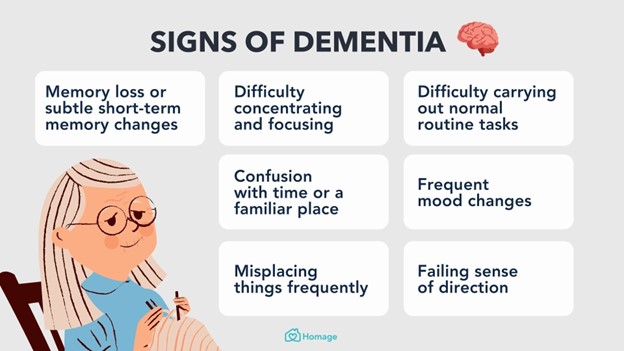A community health nurse is providing teaching to the family of a client who has dementia. Which of the following manifestations should the nurse tell the family to expect?
Decreased display of emotions
Forgetfulness gradually progressing to disorientation
Personality traits that are opposite of original traits
Decreased auditory and visual acuity
The Correct Answer is B
A) Decreased display of emotions:
While changes in emotional expression can occur in individuals with dementia, it's not a primary manifestation that is typically emphasized when educating families. Behavioral and psychological symptoms, including changes in emotion and personality, can be seen in dementia, but forgetfulness progressing to disorientation is a more direct and characteristic symptom of the condition.
B) Forgetfulness gradually progressing to disorientation
Explanation:
When educating the family of a client with dementia, the nurse should inform them to expect forgetfulness that gradually progresses to disorientation. Dementia is a progressive cognitive decline that affects memory, thinking, and reasoning. Forgetfulness is often one of the initial symptoms of dementia, and as the condition advances, individuals can become disoriented to time, place, and even people. This progression occurs due to the degeneration of brain cells and the accumulation of abnormal proteins.
C) Personality traits that are opposite of original traits:
Changes in personality traits can indeed occur as a result of dementia, but this may not be the most prominent or early manifestation that the nurse would want to highlight when educating the family. The gradual progression of forgetfulness leading to disorientation is a more specific and foundational aspect of dementia.
D) Decreased auditory and visual acuity:
Decreased sensory acuity, such as auditory and visual acuity, can happen with age and various health conditions, but they are not primary manifestations of dementia. Dementia primarily affects cognitive functions like memory, thinking, and reasoning.

Nursing Test Bank
Naxlex Comprehensive Predictor Exams
Related Questions
Correct Answer is B
Explanation
While the behavior may occupy the client's time and attention, the primary motivation behind OCD-related compulsions is not to engage in meaningful tasks but rather to alleviate anxiety caused by obsessive thoughts.
B. Decrease anxiety to a tolerable level.
Explanation: Individuals with obsessive-compulsive disorder (OCD) often engage in compulsive behaviors, such as cleaning, organizing, or checking, as a way to reduce the anxiety caused by their obsessive thoughts. In this scenario, the client's constant picking up after others is likely a compulsive behavior that serves the purpose of decreasing their anxiety to a tolerable level. The act of tidying up may temporarily alleviate the distress caused by obsessive thoughts related to cleanliness, order, or potential harm.
C. Manipulate and control others' behaviors.
The behavior described does not inherently indicate a desire to manipulate or control others. The behavior is driven by the client's internal anxiety rather than an intention to control external factors.
D. Limit the amount of time available to interact with others.
The behavior is more closely related to managing anxiety than limiting social interactions. OCD-related behaviors are driven by the need to reduce distress, not necessarily to avoid interacting with others.
Correct Answer is C
Explanation
A. The client has begun playing basketball with several other clients during the past month.
Engaging in activities and social interactions can actually be a positive sign, as it suggests involvement and connection with others, which can be protective against suicide.
B. The client identifies with problems expressed by other clients.
Identifying with others' problems may indicate empathy, but it is not necessarily indicative of suicide risk on its own.
C. The client's behavior has become impulsive in the past few weeks.
Explanation: Impulsivity can be a significant risk factor for suicide. A sudden increase in impulsive behavior might indicate that the client is not thinking clearly and is acting without considering the potential consequences. Impulsivity can lead to actions that are harmful or dangerous, including suicidal behaviors.
D. The client states she wants to go home to be with her children and partner.
Expressing a desire to be with loved ones is generally not an indicator of suicide risk. In fact, having a strong support system can be protective against suicidal thoughts.
Whether you are a student looking to ace your exams or a practicing nurse seeking to enhance your expertise , our nursing education contents will empower you with the confidence and competence to make a difference in the lives of patients and become a respected leader in the healthcare field.
Visit Naxlex, invest in your future and unlock endless possibilities with our unparalleled nursing education contents today
Report Wrong Answer on the Current Question
Do you disagree with the answer? If yes, what is your expected answer? Explain.
Kindly be descriptive with the issue you are facing.
